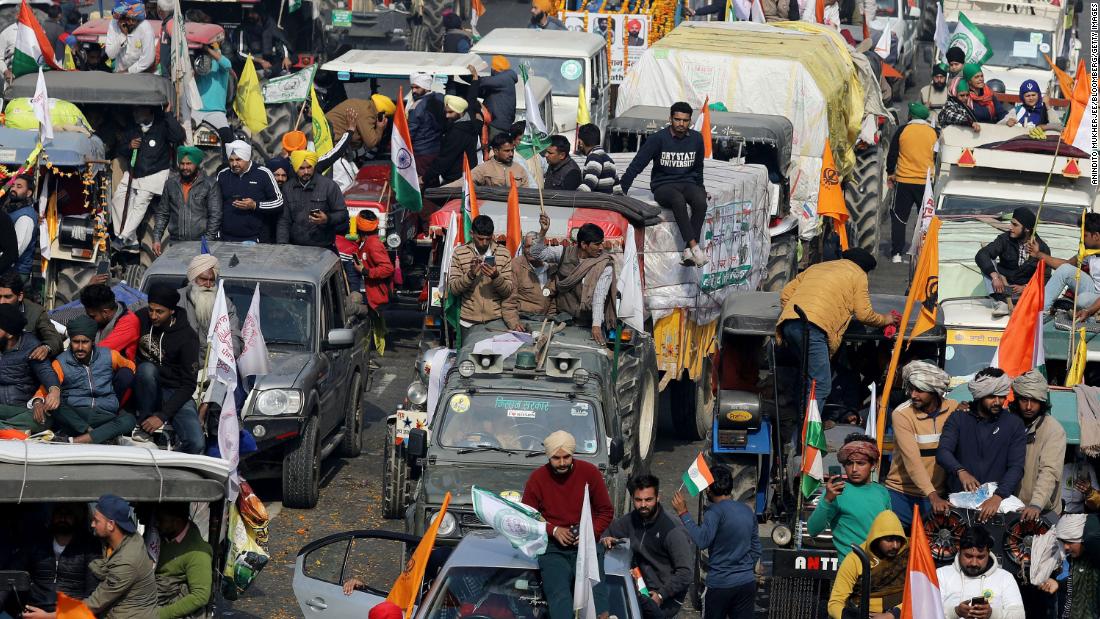Tear gas and flash bangs could be seen on live broadcasts from city streets as police moved to contain large crowds of protesters on tractors and on foot to break through the barricades. Both the police and the protesters were seen with large sticks in the streets.
Many of the farmers, who decorated their tractors with colorful flags, including the Indian flag and several farmers’ unions, camped in protest outside the capital for more than two months. Others, including young farmers from the northern states of Haryana, Uttar Pradesh, Punjab and Rajasthan, gathered at the border in recent days in time for the planned Republic Day of India march.
Police used tear gas and batons against protesters outside Delhi police headquarters and in two border areas of the city as some farmers broke through the barricades, protesters said on Tuesday.
“Outside of Delhi police headquarters, tear gas and batons were used, protesters also attacked police buses stationed there,” said Paramjeet Singh Katyal, spokesman for Samyukt Kisan Morcha, the umbrella group representing the unions. of farmers.
“We broke through the barricades, we have our tractors, people are marching, some leaders are also on horseback … thousands of farmers have already arrived in the capital,” said Katyal.
At the Ghazipur border between Delhi and Uttar Pradesh, police used tear gas and batons to repel nearly 2,000 protesters, and tear gas was also used at the Singhu border between Delhi and Haryana on Tuesday morning, according to Ashutosh Mishra , spokesman for All India Sangharsh Coordination Committee, one of the unions leading the protests.
Although the police gave farmers permission to hold a tractor rally in Delhi, they put a limit on 5,000 tractors, according to Mishra. However, more than 200,000 tractors were deployed, with many young people coming from neighboring states, said Darshan Pal, president of Krantikari Kisan Union, one of several protest leaders.
A Delhi police spokesman, Anil Mittal, said they did not have a statement about the clashes, just saying “we just asked the protesters to keep the peace”.
For decades, the Indian government has offered farmers guaranteed prices for certain crops, providing long-term certainty that, in theory, allowed them to make investments for the next crop cycle. The new agricultural laws, first passed in September by the Modi government, allow farmers to sell their produce to anyone at any price – giving them more freedom to do things like sell directly to buyers and sell to other states.
But farmers argued that the new rules would make them worse off, making it easier for companies to exploit farm workers and helping big companies to lower prices. Although farmers can sell their crops at high prices if there is demand, on the other hand, they may find it difficult to meet the minimum price in years when there is a lot of supply on the market.
The laws have been very controversial because agriculture is the main source of livelihood for about 58% of India’s 1.3 billion population, and farmers have been arguing for years to raise guaranteed minimum prices. They are the country’s largest electoral bloc – making agriculture a central political issue.
There were demonstrations that lasted for days along each of New Delhi’s three borders. Farmers blocked roads and set up makeshift camps, some sleeping on the road or in their tractors. They arrived from several different states to participate in the mass protests, sometimes in confrontation with the police.
The government has held 11 rounds of negotiations with leaders of more than 30 farmers’ unions that are opposed to the laws – but the negotiations have come to nothing.
Increasing the pressure, protesters said on Tuesday that, in addition to the three routes to the city designated by the Delhi police, they intended to march at six points on the city’s borders, as well as in the northern states of Haryana, Rajasthan and Uttar Pradesh , according to Yogendra Yadav, leader of the farmers’ protests.
Farmers’ unions also plan to march to parliament on February 1, the day that parliament will hold its budget session, said Yadav.
To control the crowd, the Delhi traffic police created detours along several highways and main roads in the city, and the subway closed exits at at least 15 stations close to the protest sites.
